In the early 70s the widespread deployment of helicopters mounting anti-armour missiles was of great concern to the US Army. The US had deployed these weapons successfully during the 1972 Easter offensive in Vietnam. This had highlighted that the current US anti-aircraft weapons were inadequate to deal with this threat. The Soviets also had this type of missile and it wouldn’t be long until the technology gap was closed.
At this time the US deployed three anti-aircraft vehicles. The M42 Duster carried twin 40mm Bofors guns but was a relic from the early 50s. In Vietnam it was used for ground support. The M163 was a bucket with a 20mm Gatling gun. It had range only radar and was also mostly used for ground support. The M730 was another bucket, this time of the tilly variety which had a launcher carrying four sidewinder missiles.
Each of these systems had extreme difficulty engaging pop up targets at 4000meters, the maximum range of wire guided missiles at that time. The M42 had neither the range nor accuracy, it had been retired by 1963 only to be reactivated when the replacement system failed. The 20mm cannon on the M163 theoretically had the range but had a simple lead only calculation radar that was useless for that range. The weapon could be fired using the optical sights using the spray and pray method. The M730 required vision of an exhaust for long enough for the missile to lock on. Not overly useful as the front of the helicopter would be facing its target.
In 1977 the requirement for a DIVisional Air Defense (DIVAD) vehicle was launched by the US Army. The new gun would be capable of engaging fleeting targets at ranges out to 3000 meters, in all weather, it had to acquire the target and engage within five seconds and have a 50 per cent chance of destroying the target with a 30 round burst. In addition, it was to have optical tracking, FLIR, Laser rangefinder as well as tracking and ranging radars. In order to cut development time, the system was to use as many off-the-shelf components as practical. All proposals were to be based on the M48A5 tank which was being retired with the arrival of the M1 Abrams. This decision would later bite them on the arse.
There were many proposals from industry of which the most interesting was from General Electric which utilized the 30mm Avenger cannon from the A10 Thunderbolt II aircraft. The proposal from Raytheon placed a Gepard flakpanzer turret with Dutch fire control on the M48. Only two of the proposals were ordered as prototypes for a competitive selection process. These were from General Dynamics featuring twin 35mm Oerlikon canons and fire controls from the Navy Phalanx CIWS and the Ford Aerospace entry featuring twin 40mm Bofors guns and radar from the F16 Fighter. This vehicle was often nicknamed the “Ford Gunfighter”
At this point, the political shit-fight began in earnest. Ford wanted to use Bofors guns despite 35mm being the Nato standard round. Ford had a marketing agreement with Bofors and claimed that the potential profits benefits would be higher with the larger caliber as it could use a proximity fuse. Ford lawyers made the case that using the Nato cartridge was anti-competitive and specifying the caliber could lead to future lawsuits. One high-ranking Pentagon official was quoted as saying, ‘It’s the most ludicrous excuse I’ve ever heard’. The final requirement when issued specified a gun in the 30mm-40mm range.
The prototypes were delivered to Fort Bliss in June 1980 for competitive trials. These would continue for a period of 29 months. During shooting trials, a total of 28 targets were shot down. This would include two F86 Sabres, five UH-1 Hueys and 21 smaller drones. By all accounts the GD prototype won the shootout by 19 to 9, however the Ford vehicle was ordered into production. The reason generally stated is that the 40mm used a proximity fuse which could damage the target without hitting it. Drones that had survived were generally peppered with shrapnel holes. This would indicate that these weapons targeted the aircraft’s most vital system, the pilot. Drones would require a vital system to be struck otherwise they could and frequently did survive. The 35mm required a direct hit but had a higher rate of fire and a greater weight of shot in the same time frame. Target struck by the 35mm HE would be ripped apart.
The other nice thing about proximity fuses is that the fuse can detonate the shell after a certain amount of time. This stops your nearby allies being showered with live HE shells. The maximum range of the 40mm was 12 kilometers and what goes up must come down. Shrapnel falling at gravity is a lot better than a stream of contact fused HE. Ford got the contract for a sum of $6.97 billion for development and production. The new system was named as the M247 Sgt York.
Problems with the ‘Gunfighter’ occurred almost immediately. Its radar could not distinguish between low flying aircraft and trees. It couldn’t filter out ground clutter. When the guns were at high angles, the barrels projected into the radar line of sight confusing the radar. It didn’t like water or the cold. The reaction time to track targets was too slow. The hydraulics leaked like a sieve. The electronics could be easily jammed. The gun barrels had come from US Army stocks and were bent due to mishandling in storage.
The Gunfighter was famous for its misbehavior during demonstrations. On one such demonstration the turret trained itself on the reviewing stand immediately when the computer was activated. There were several injuries as the reviewing officers, VIPs and Congressmen all scrambled for cover. The system was shut down and after some work was successfully restarted. When firing commenced against a drone, the guns refused to elevate and fired into the ground 300m in front of the vehicle. A Ford technician later stated that the problem was due to the vehicle being washed before the demo. In the official report of the tests, the reviewer ‘wondered if it ever rained in Central Europe’.
This was not the only time it failed. In one demo before defense journalists, it targeted an exhaust fan on a dunny block seeing it as a low flying threat. It fortunately did not open fire. Drones were a problem for the system, it had difficulty in tracking them even in a straight line. This was rectified by attaching a radar reflector to the drone. One proved insufficient and eventually 4 were attached. This was likened to demonstrating the abilities of a bloodhound by having it find a man standing alone in the middle of an empty carpark, covered in steaks. The system was now able to track the target and it successfully engaged the drone with its proximity fused projectiles. The drone was not destroyed but was damaged enough to veer off course in an unsafe direction and it was remotely detonated by the range safety officer. This was seen by the press as an attempt to fake the results, and future good results were tainted by the fake claim.
Eventually most of the problems would be resolved but the system remained horribly unreliable with only 30% availability. Of the 163 contract requirements, only 22 were not fully resolved. By mid-1985, the system was still deemed not effective in protecting friendly forces. The vehicle was cancelled in Aug 1985 after 50 production vehicles were produced. The main failure at this point was that the tank could not keep up with formations of Bradleys and Abrams. Who would have guessed that a 50s era design with an extra 20 tons of turret couldn’t keep up with vehicles with a 15mph speed advantage. The other major issue was that the Soviets had now fielded missile with a 6Km range, well beyond the effective range of the Sgt York.
There are three surviving vehicles on public display. The rest ended up on various bombing ranges. A fitting end for a failed anti-aircraft vehicle.
By the time of the Operation Dessert Storm, the US Army still did not have a modern SPAAG. This role was filled by LAV25s armed with a 20mm Gatling and Stingers, and with a Hummer variant armed with stingers. These were both temporary solutions and have been replaced by the M6 Linebacker, a Bradley with a stinger launcher in place of the TOW. The US Army air defense policy is reliant on the USAF achieving total air superiority. This was vindicated in both Iraq and Afghanistan. Would it work in Europe, who knows?

The Tamiya M247 Sgt York
First, the elephant in the room. Not all Tamiya kits are good and this one is a stinker. It’s not T62 bad but it’s up there with the likes of the Chieftain and Leopard 1. It does assemble okay but had major accuracy problems. In fact, this is not a model of a Sgt York but is based on the wooden mockup of the Gunfighter.
The model is based on the M48A3 kit released in 1981. This was an okay kit back in the day but has not aged well. The M247 was based on the M48A5 variant and this itself was an upgrade to the M48A3. Production hulls selected for the M247 were all the Mod B variant where as the M48 kit depicts the Mod A. There are several visual differences including the pattern of the fenders, the headlights and protection of the rear engine vents.
The M247 kit has a revised upper hull and they have half-arsed it. The M247 had a completely different rear deck. The upper hull was revised to the B model, with a change to the fenders but these are lacking the pressed in Xs that are the strengthening for the sheet metal. The headlights are right for this variant as are the top loading air cleaners. The rear deck is unchanged from the M48 but has an additional vent provided. This vent appears on the mockup. Production vehicles had totally different rear ends with an extensive venting array.
The lower hull is unchanged from the M48 and is a nightmare of huge motorization holes. The tracks have been changed to the more modern octagonal track pads. The hull sits way too high as the original kit was patterned from an empty vehicle. Another issue is the shape of the nose. The kit is much too blunt and this is not really fixable.
The turret is an entirely new production. The kit was released in 1983 and is obviously before production vehicles appeared. I’ve had one of these kits in the stash for many years, waiting for someone to do a conversion kit to fix it. Takom have recently announced a new tool, rendering this kit more worthless than when it was released. As it’s worthless I might as well use it for testing paints.
Construction
Pretty easy with these old Tamiya kits. First there are a number of mounting holes that need to be drilled holes out in the upper hull. Next plug all the motorization holes. There is a big gap at the rear between the upper and lower hull so this will also need plugging. I used a large amount of sheet styrene and a lot of putty. If you wanted to fix the stance, you would need to cut off the shock absorbers from each of the roadwheel arms and shorten them. The road wheel arms would also need to be repositioned. Oddly, the first arm doesn’t line up with the others, it sits 1mm higher. Don’t know why but it may be also due to motorization.
The periscopes around the driver’s hatch have no lenses so some sheet styrene was added. The wheels are held on by internal poly caps and the tracks are vinyl needing pins to be melted to make the loop. Most parts that are added to the hull are fitted into slots. The slots tend to be oversize so plenty of putty is needed. Add the fender bracing before any fender boxes otherwise access will be tight to fill the bracing slots.
Paint
The instructions designate that the vehicle is painted in a MERDC scheme. This scheme was a system comprising 12 colours used for eight different official schemes. It was in use from 1972 through to the mid to late 80s. The system had summer and winter schemes and it was left to the user units to apply the paint. The result varied considerably depending on who applied the chalk. The production M247s all appear to be in plain olive drab as units in the continental United States were generally not camouflaged until they were to be shipped to theatre. The Gunfighter appears to have been in Red Desert. The M48A5 donor vehicle appears to have been in that scheme so this was carried on to the prototype. At some point the prototype was repainted to Summer verdant.
I had acquired a set of AK Interactive acrylic paints specific for MERDC. This contains eight of the 12 colours, including the mystery Field drab. I say mystery because this colour is usually stated as a percentage mix between dark earth and another colour. This pack identifies it as FS30118 which is the tan used as part of the USAF SEAC scheme.
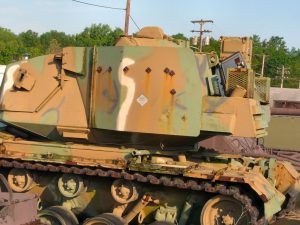
Faded Field drab (brown)
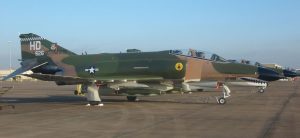
USAF SEAC scheme
The other colours are:
AK11342 Dark Green (FS34102).
AK11335 Light Green (FS34151).
AK11343 MERC Sand (FS30277).
AK11344 Field Drab (FS30118).
AK11337 Earth Yellow (FS30257).
AK11346 Forest Green (FS34079).
AK11338 Earth Red (FS30117).
AK11001 Insignia White (FS37875)
The missing colours are OD FS34087, Black, Earth brown FS30099, Desert sand FS34087.
The pack also has examples of each of the schemes along with the required colours. For red desert, Earth red, Earth yellow, sand and black would be required according to the box.
As usual, I started with painting everything below the guards with Nato black. As all wheels have poly caps and the tracks are vinyl, these were removed to ensure a good coverage for the undercoat.
Next, the vehicle was painted with broad random areas of earth red and earth yellow to 50:50 proportions for the base. The accent colours were sand and Nato black, added randomly between the bases colours with an occasional crow’s foot. The base colours should be 45% each with the accents both being 5%.
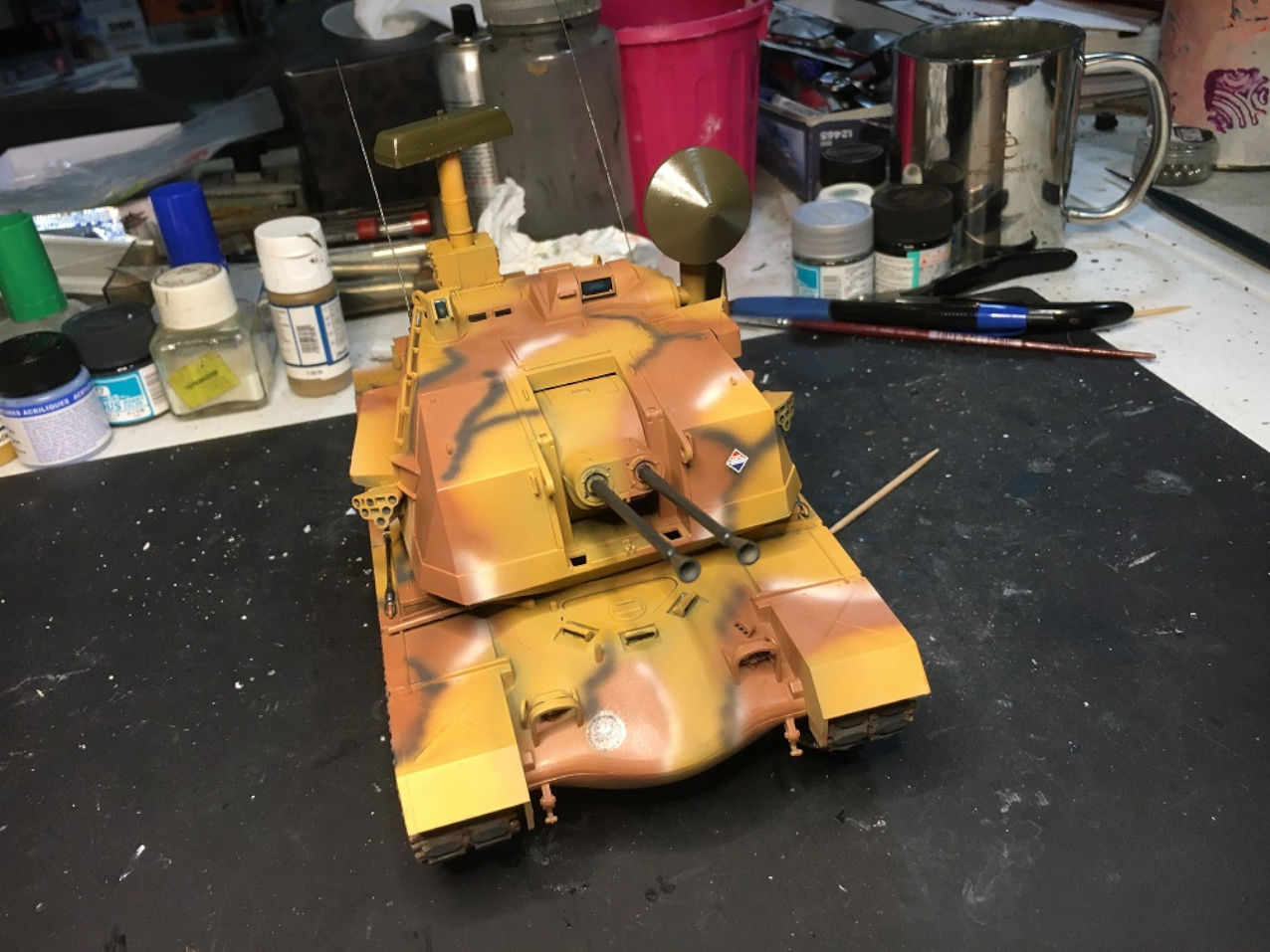
Hmmm, something not quite right here
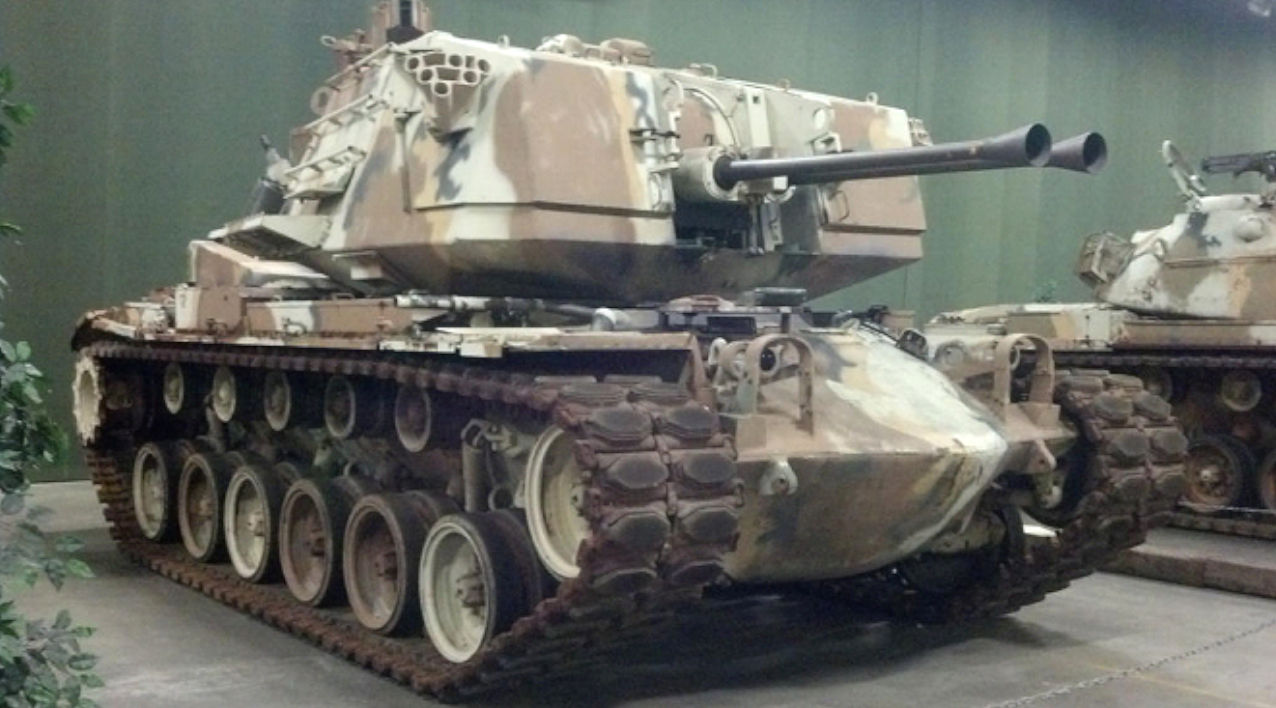
This is what it should look like. The brown supplied is too red. The sand should be the base and yellow the accent.
Like most water based acrylics, these are not the easiest to spray. They have a tendency to clog in the needle and spatter. Pigmentation seems to be thin so a number of coats are needed. Pressure is also finicky as higher air flows tend to dry the paint. I find these paints to be much more difficult to use than Gunze alcohol based acrylics. Once the base was done, detail painting was done by brush with Gunze acrylics.
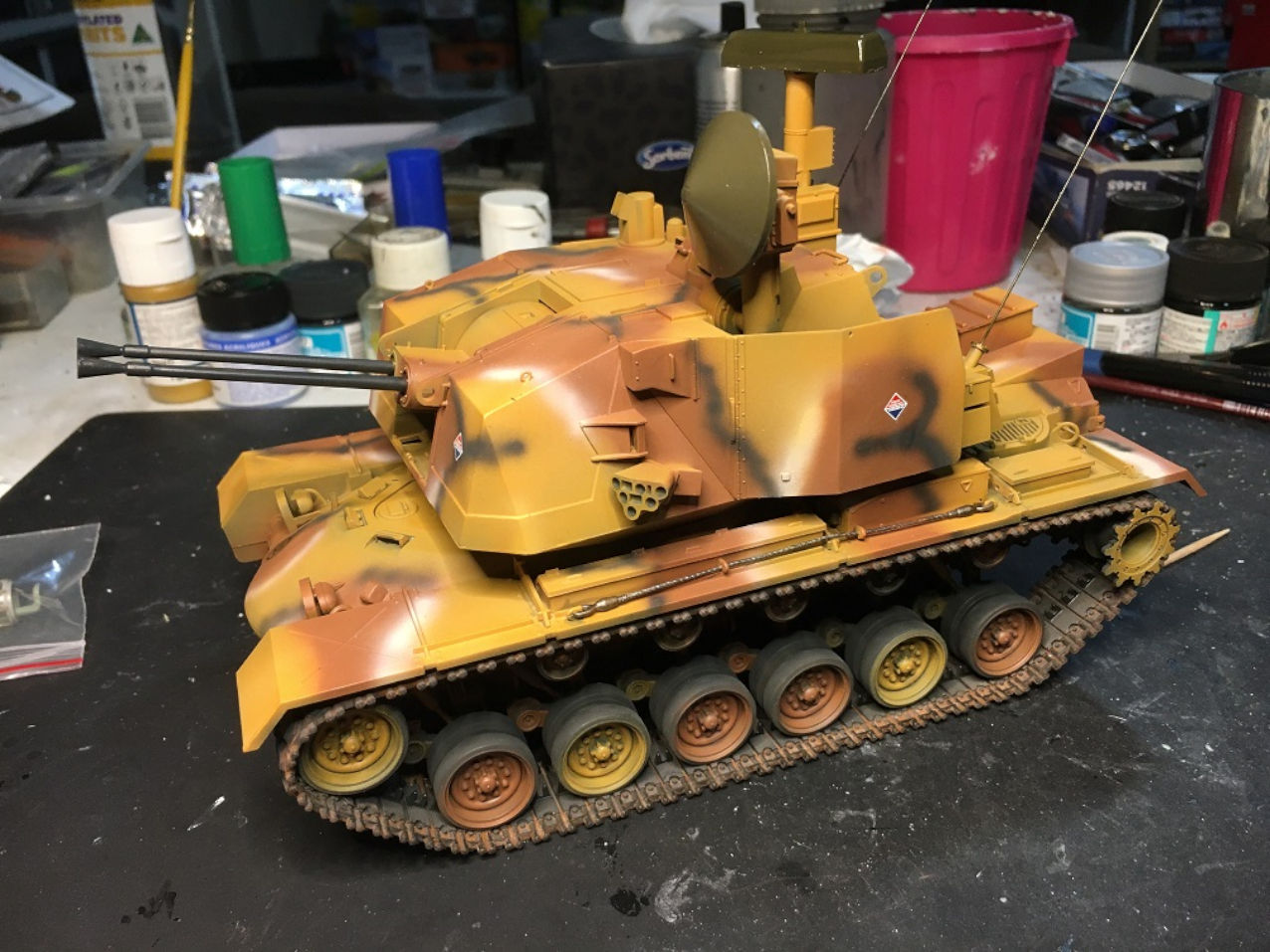
Note the ammo storage doors and placement of the smoke dischargers compared to the actual vehicle
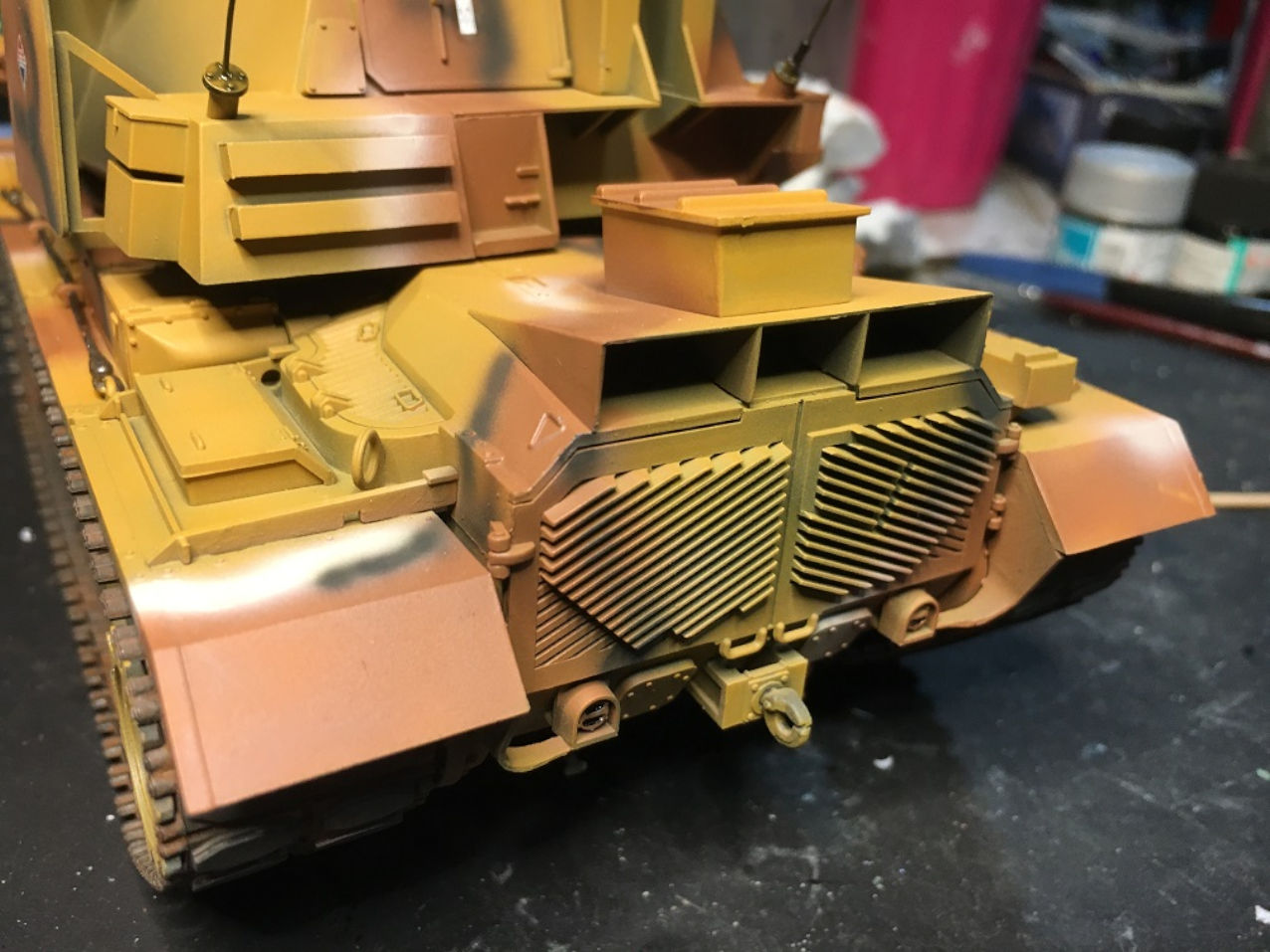
The dodgy rear end
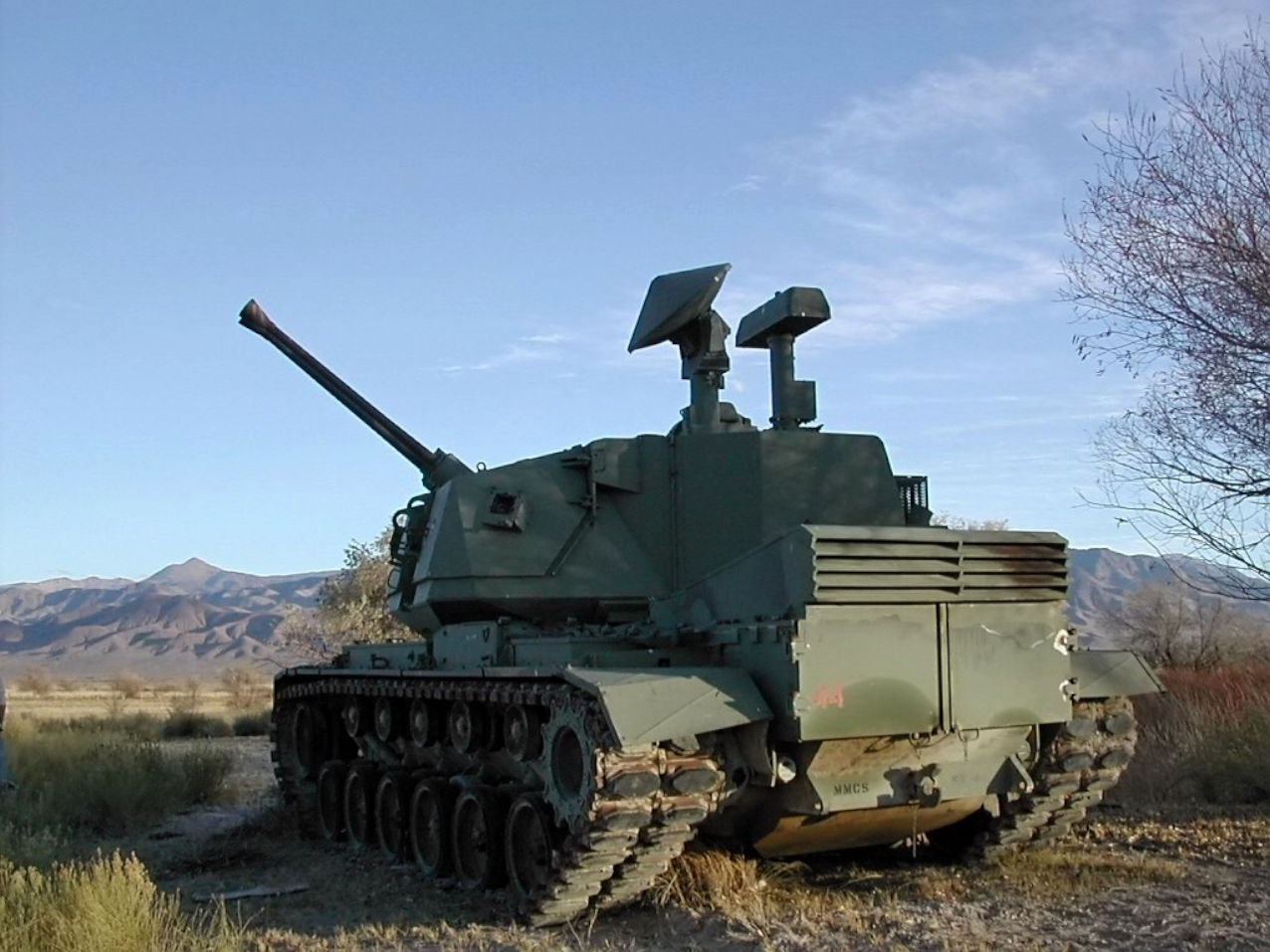
This is what the rear end should look like
Conclusion
Rubbish vehicle, rubbish kit, rubbish paint. It needs some weathering. Someone hand me a slug gun.
Steve Pulbrook
December 2022
